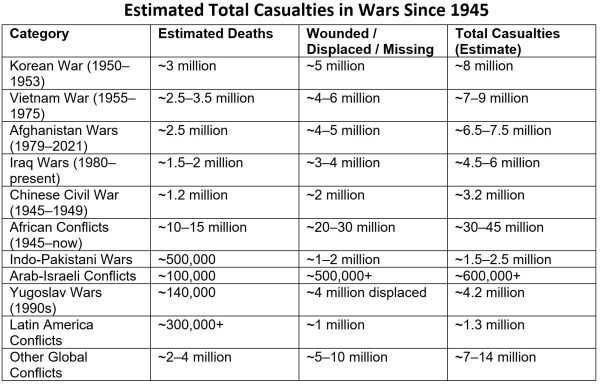We have entered an era in which warfare has departed from the conventional (Clausewitzian) concept of attaining clear objectives. Instead, modern armed conflict is characterized by limited and generally inconclusive military clashes motivated by factors disconnected from the practical concerns of the affected citizens. War has turned away from decisive conflict and embraced performative spectacle. This metamorphosis is a kind of reverse evolution in which modern nations are adopting the elements of primitive warfare, but amplifying them through global mass media. I will provide evidence for this argument and discuss the implications.
The Extinction of Total War
The memory of past world wars informs the public’s understanding of warfare, but WWII concluded with the invention of nuclear weapons, an epochal event. The subsequent accumulation of nuclear arsenals made all-out war intolerably destructive. All succeeding wars have been highly limited in their geographic scope, and none have resulted in casualties approaching the appalling 70-85 million killed in WWII (3% of the world’s population). Although an apocalyptic global nuclear war is a terrible lingering possibility, nuclear-armed nations have thus far avoided it.

What we have seen is a series of limited wars that have seldom resulted in clear-cut victories. For 80 years, nations have expended blood and treasure on armed conflicts with very little change in territorial boundaries. Why has the world settled into this pattern of incessant low-level warfare? I believe that the answer is the convergence of three factors: political manipulation, perverse economic incentives, and public appetite for military violence.
Heroes Without Victories
The U.S. war against the Taliban regime in Afghanistan provides an example of how an unsuccessful limited war was sustained for many years at great expense for no practical purpose. Over 20 years, the U.S. spent approximately $2.3-$2.6 trillion attempting to defeat the Taliban. Despite the commitment of 100,000 troops, the U.S. was unable to achieve its objective of transforming Afghanistan into a democratic regional ally. When this project was abandoned in 2021, the main political consequence was public unhappiness with the disorderly troop withdrawal. There were no serious repercussions for the political and military leaders responsible for the war. Although a military failure, the war was successful in advancing political and military careers; it generated substantial revenue for military contractors; and it provided public entertainment.
Politicians touted the fighting in Afghanistan as a key element in the “War on Terror.” The Afghanistan War benefited many U.S. politicians by enhancing their patriotic image, increasing campaign funding from defense interests, expanding executive authority, and enabling them to project strength. Defense contractors reaped over $100 billion in revenue from this war. At the high point of hostilities, contractors outnumbered military personnel in Afghanistan 3:1. The public supported the war for most of its duration because of a steady stream of favorable media coverage of U.S. troops in combat. For example, the film Restrepo was an award-winning documentary that focused entirely on the sacrifice and heroism of soldiers in Afghanistan with no consideration of the larger issues of the war. For many Americans outside the war zone, the Afghanistan war was a satisfying form of entertainment. Although few people would admit to enjoying the spectacle of wartime death and destruction, how else can one explain the duration of the Afghanistan war and the almost complete absence of public anger at the wasted effort?
The public’s appetite for violence is nothing new. Deadly gladiatorial combat in the arena was a major form of entertainment in the Roman Empire, lasting for over 500 years, until it was banned in the fifth century AD. Modern politicians cultivate reputations for belligerence. In 2007, Donald Trump used the setting of a professional wrestling bout to establish his status as a brawler. Now that he has returned to the White House, he regularly threatens nations with punitive sanctions and military violence, much to the delight of his followers. The public clearly prefers spectacle to substance, and U.S. politicians strive to deliver it.
Israel has fought a series of limited wars against its neighbors in the Mideast since the founding of the state in 1947. Although each war resulted in a short-term victory, expanding Israel’s territory and military strength, there has been no lasting peace. Instead of turning away from war, Israelis have become increasingly bellicose. In the most recent fighting in Gaza, some Israelis gathered to enjoy observing the bombing of Palestinians.

Israeli citizens observing the bombing of Gaza
Israel’s adversaries are just as keen on enjoying their occasional military successes, as evidenced by videos of recent Iranian missile strikes on Tel Aviv set to music.
🚨⚡️ The song “Boom Boom Tel Aviv” just got nominated for a Grammy! 🤣🤣
Music hitting harder than missiles. 🎶💥 pic.twitter.com/AiFPGKmrmV
— RussiaNews 🇷🇺 (@mog_russEN) June 20, 2025
Limited War Resembles Primitive War
Many limited conflicts today share key characteristics with primitive ritual warfare—emphasizing spectacle, posturing, and political messaging over total victory. Nuclear deterrence, media saturation, and economic incentives all encourage this shift toward symbolic conflict. Here are some of the parallels:
- Symbolic Weapon Display and Posturing — The modern equivalents of brandishing spears are provocative military hardware displays, such as warships sailing through contested waters and ballistic missile testing.
- Exchange of Insults and Psychological Operations — Coded insults and social media campaigns are today’s methods for verbal assaults attacking adversary morale. No physical shouting is required.
- Avoidance of Serious Casualties — In Afghanistan, U.S. combat deaths averaged only about 100 per year over a 20 year period. U.S. reliance high-tech weaponry and proxy forces minimizes casualties.
- Theatrical and Cyclical Nature of Conflict — In the Mideast wars and the wars between India and Pakistan, there has been a similar repeating pattern of threats, fighting, and ceasefires, then a lull before the next round of hostilities. This resembles primitive tribal conflicts.
- Social and Political Utility of Controlled Violence — Military action rallies public opinion, distracts from domestic problems, and affirms leadership. It is politically useful even when tactically indecisive — the same as it ever was.
- Spectacle and Public Consumption — Televised airstrikes, real-time combat footage, and viral combat montages make the public emotionally invested in displays of dominance and proficiency. Today every display screen can be a theater of violence, and the audience is no longer limited to a gathering of tribes.
The Power of the Video Arena
As war has become performative, video has become its primary means of distribution. The torrent of video captured by body cams and cell phones is augmented by streams of fake or AI generated imagery, all aimed at arousing the emotions of spectators in a global video arena of war.
Conclusion
It is likely that the world will suffer from performative war for many more years, but I believe that technological advances will steadily increase conflict damage to the point that the costs will exceed the benefits. As weapons become smarter, cheaper, and more numerous, more combatants will gain access to them. Criminals, terrorists, revolutionaries, and political splinter sects will all have the ability to inflict devastating damage on their adversaries. The “leakage” of weaponry supplied to proxies in limited wars will become problematic as some of these weapons are turned against their suppliers. This will result in a return to diplomacy and application of international law for dispute resolution. Bloodthirsty media spectators will be satisfied by AI generated arena combat, and people will no longer die so that others can be motivated and entertained by the spectacle.






